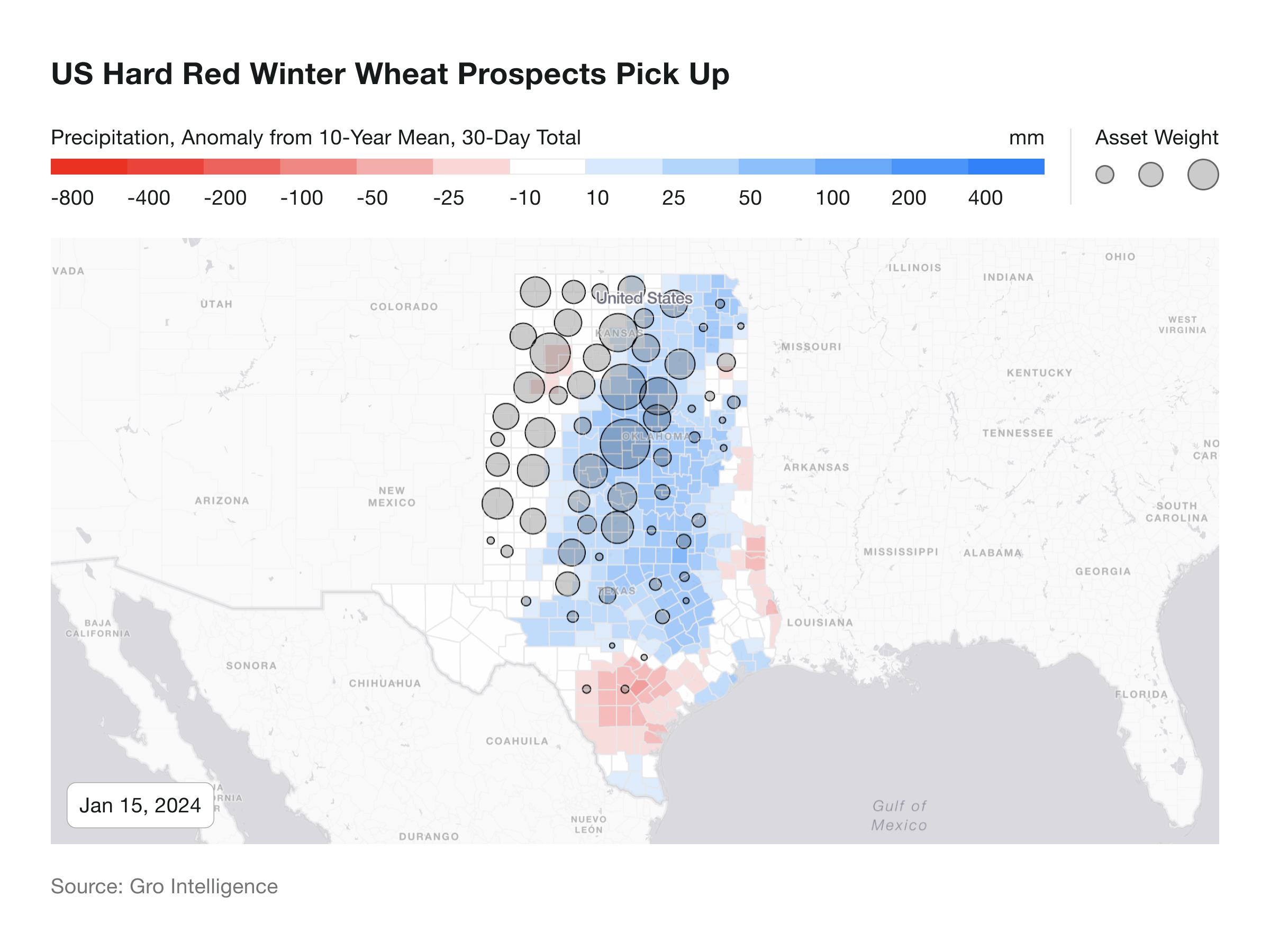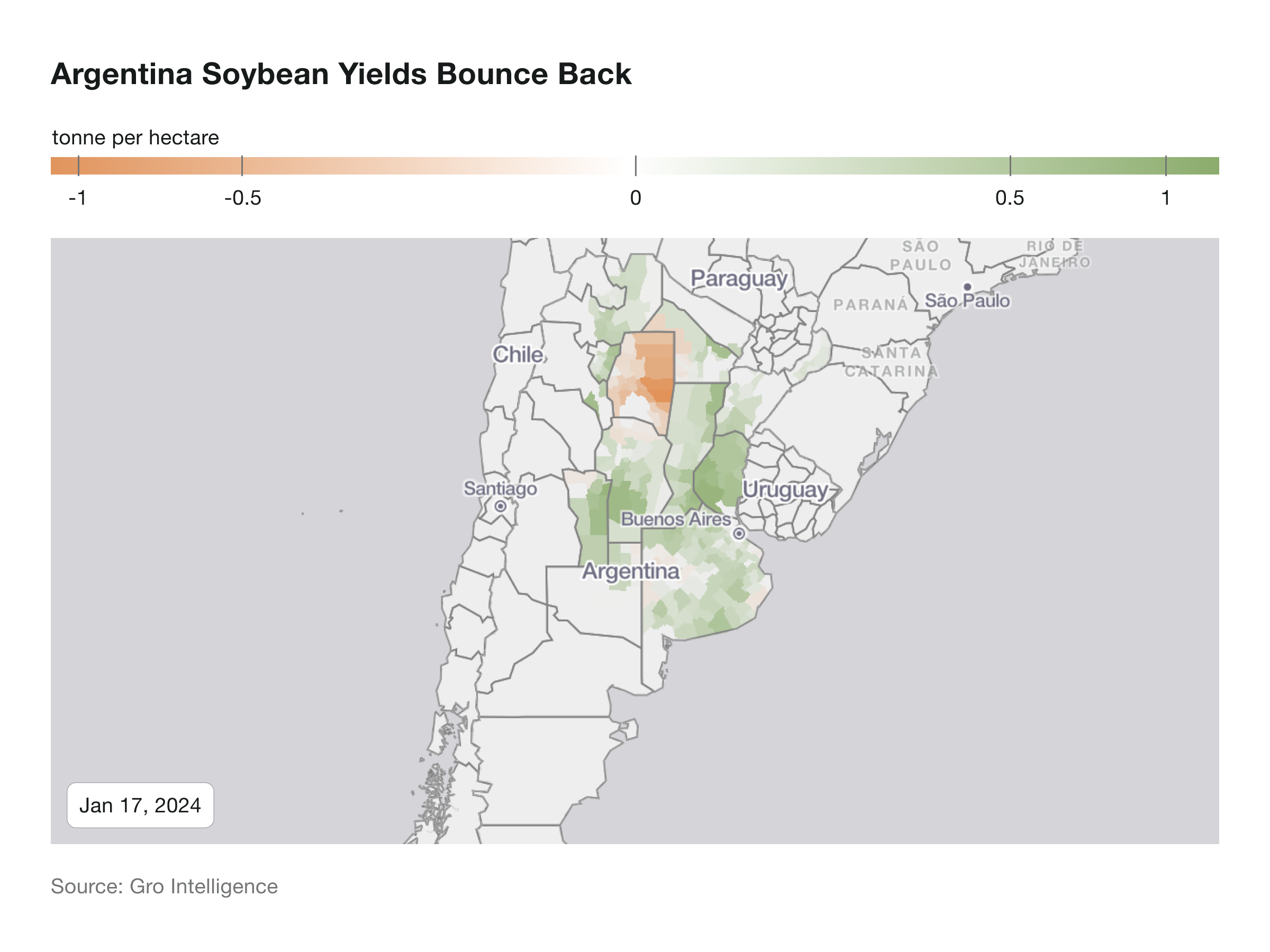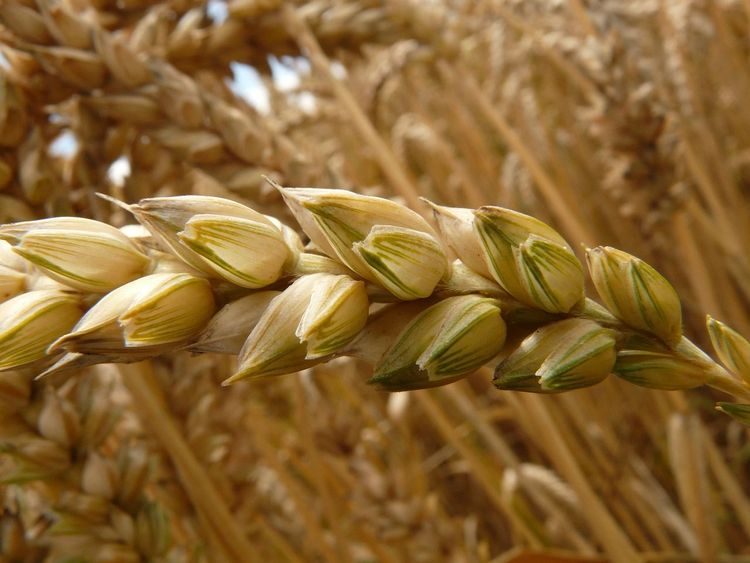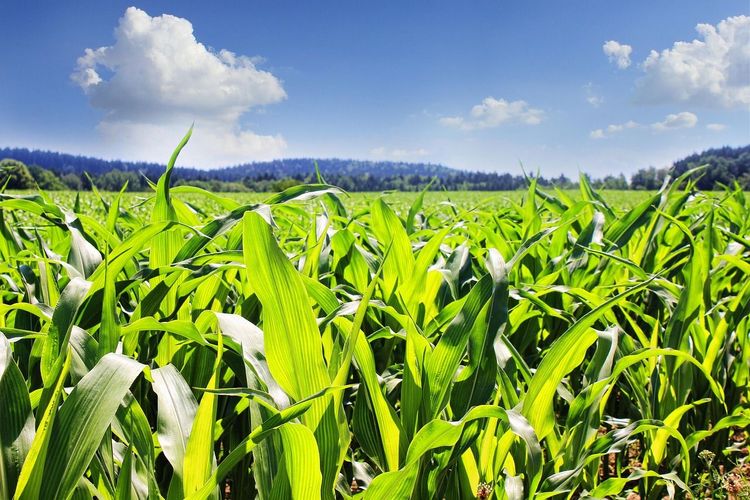Gro’s 2024 Watchlist: 7 Major Themes for Agriculture in the Year Ahead
A year ago, we at Gro correctly predicted that the sharp food price increases seen in preceding years would begin to moderate, although some inflationary pressures would persist worldwide.
Looking ahead to 2024, Gro forecasts a continued calming of global food price inflation, helped by factors including China’s economic slowdown, improved fertilizer affordability, and an expected easing of US interest rates — a boon to import-reliant countries.
The impact from El Niño, which took hold midway through 2023, will be felt worldwide through at least the first half of 2024 — bolstering supplies of some agricultural commodities, including corn and soybeans, but shrinking others, such as rice and robusta coffee.
Gro’s forecasts for the Top 7 major themes for global agricultural markets in 2024 are:
- Food Price Inflation Will Continue to Ease
- El Niño Will Have Sweeping Impacts on Global Agriculture
- Global Wheat Supplies Will Rebound After Multi-Year Declines
- World Corn and Soybean Supplies Will Rise
- China’s Slower Economic Growth Will Affect Agriculture Worldwide
- Nitrogen Fertilizer Prices Will Retreat to Historical Levels in Second Half
- US Protein Prices Will Remain Strong
Gro Intelligence analyzes the vast amounts of data on our platform to see around the corner of global agricultural developments and to produce machine learning-based predictive models that generate valuable knowledge and insights. Gro is the only platform showing the dynamic impact of climate, economic factors, and agricultural systems on each other.
Here are the details behind Gro’s forecasts for the Top 7 major themes for global agricultural markets in 2024:
Food Price Inflation Will Continue to Ease
Gro expects the easing of food inflationary pressures that emerged in 2023 will continue in 2024, especially in the US. Still, risks remain, including continued currency weakness in emerging economies, El Niño and its impact on several key growing regions, and an expected continuation of trade protectionist measures.
- Increased supplies of some commodities, including corn, soybeans, and wheat, will help dampen inflationary pressures in 2024.
- Lackluster economic growth in China will likely curb the country’s demand for agricultural product imports and help contain global prices.
- In the US, Gro’s US Food Price Index — which has proved to be predictive of inflation trends as much as six weeks ahead of official government reports — indicates that price pressures on food and beverage companies will remain benign for a second year running. The consumption-weighted Food Price Index was down 3.7% in January 2024 from a year earlier. Still, the Index is up 12% since 2020, when global food price gains began accelerating. The Gro US Food Price Index can be viewed in Gro’s Custom Price Index application.
- Expectations that US interest rates will ease in 2024 could reduce price pressures in import-dependent developing economies. With many agricultural products priced and traded in US dollars, tight US monetary policy has exported inflation to food importers.
- Food inflation has already slowed in some import-reliant countries, although price gains continue to be punishing. In Turkey, for example, food prices are currently up 484% vs. 2020, but that’s well below levels seen last July when prices were up 566% compared to 2020, according to Gro’s Agricultural Price Inflation Application, which measures a basket of commodities in local currencies.

Gro’s US Food Price Index was down 3.7% in January 2024 from a year earlier. Still, the consumption-weighted Index is up 12% since 2020, when global food price gains began accelerating.
El Niño Will Have Sweeping Impacts on Global Agriculture
Some of the most profound effects on worldwide agriculture in 2024 will come from the El Niño climate event that started in the second half of 2023 and replaced La Niña conditions, which had prevailed for the previous three years. Climate scientists forecast El Niño will be with us at least through the April-June period of 2024.
- Key growing regions in the Americas have benefited from rainfall linked to this season's El Niño after consecutive years of devastating drought ushered in by La Niña.
- El Niño is helping Argentina recover from the dismal, drought-hit harvests of 2023, with much larger production of soybeans, corn, and wheat forecast for 2024. In the US, early winter wheat prospects are much improved from recent years, as Gro wrote about here.
- In Southeast Asia, however, El Niño has brought erratic rainfall and increased dryness. That presents risks for crop production in several countries — including reduced yields for rice and coffee in India, Thailand, and Vietnam, and for palm oil in Indonesia.
- The divergent crop prospects as a result of El Niño will affect global trade flows. Australia, with smaller 2023 wheat production due to El Niño, will likely play a diminished role in global wheat trade for much of 2024. And Argentina, normally the world’s top exporter of soybean meal and soybean oil, will likely regain some of the market share it lost in 2023 to competition from the US.
Global Wheat Supplies Will Rebound After Multi-Year Declines
Supplies of wheat, the world’s most widely grown grain, look set to rebound in 2024 after four straight years in which stocks, excluding China, have declined, according to Gro’s machine learning-based forecast models.
- A favorable start to winter wheat crops in the US and Russia, along with improved prospects for crops that will be planted later in 2024 in Argentina and Australia, is expected to lift world wheat inventories, as Gro wrote about here .
- In the US, promising early season conditions — and weather forecasts that currently look favorable for the next few months — suggest that US hard red winter wheat (HRW) yields could recover after years of drought. However, planted acreage is down from last year.
- Russia’s next winter wheat crop is also benefiting from favorable conditions. Gro’s Russia Winter Wheat Yield Forecast Model currently is projecting yields above this time last year, although conditions can change when the crop emerges from dormancy in the spring.
- Prospects for China’s winter wheat crop are currently looking better than last year, according to Gro’s China Wheat Yield Forecast Model. In 2023, late season heavy rains caused extensive damage to the crop.
- An exception to global wheat’s upbeat outlook: India’s wheat harvest, which begins in March, will decline in the wake of 2023’s weak monsoon. That will increase pressure on the government to extend the country’s current wheat export ban, amid already low domestic wheat supplies, as seen with Gro’s India Wheat Yield Model & Balance Sheet.

Early season conditions suggest that US hard red winter wheat (HRW) yields could recover after successive years of drought. This precipitation anomaly map from Gro’s Climate Risk Navigator for Agriculture compares rainfall over the past month with the 10-year mean for Kansas, Oklahoma, and Texas, the three main HRW growing states. Circles indicate HRW growing areas.
World Corn and Soybean Supplies Will Rise
Global inventories of corn and soybeans, excluding China, have declined for most of the past five years. 2024 will bring a reversal of that trend, Gro forecasts, as higher production in several countries, helped in part by El Niño, lifts corn and soybean stocks.
- Argentina’s corn and soybean production looks likely to rebound from last year’s weak harvests, with soybeans perhaps as much as doubling. Previous El Niño years in Argentina, including 2019 and 2015, saw higher corn and soybean yields compared with La Niña years, as seen in this Gro display.
- US corn production hit a record in 2023 after the crop overcame early season challenges from extreme heat and drought. Despite increased corn export demand, US corn ending stocks are headed to the highest level in five years. However, US soybean ending stocks will remain tight, allowing farmers to shift corn area to soybean acreage in 2024.
- Brazil is the world’s largest producer and exporter of soybeans, and its record crop in 2023 helped offset production declines elsewhere. Brazil production will continue to be strong in 2024, though down year over year, according to Gro’s Brazil Soybean Yield Forecast Model.

Argentina’s soybean yields are currently forecast to rise sharply after last year’s drought-hit dismal crop, according to Gro’s Argentina Soybean Yield Forecast Model. This map from Gro’s Yield Model Anomaly application compares forecasted yields in major soybean growing regions with their five-year historical average. Argentina is the world’s largest exporter of soybean oil and soybean meal.
China’s Slower Economic Growth Will Affect Agriculture Worldwide
An expected slowdown in China’s economic growth in 2024 will have a far-reaching impact on agricultural industries worldwide. China is the world’s largest purchaser of agricultural commodities.
- China’s livestock industry is under pressure, with negative producer margins generating losses for both hog and broiler chicken producers. Meat consumption growth will slow in 2024, Gro predicts, after increasing by 3.6% in 2023 and a five-year average pace of 2.1%. As a result, China’s meat import volumes are facing downward pressure.
- Soybean imports, which reached a record 100 million tonnes in 2022/23, will likely be flat to lower in 2024. With China’s hog population unlikely to increase, any feed demand growth will be muted.
- Corn imports are unlikely to increase significantly after higher planted acreage and favorable yields boosted domestic production for 2023/24. Brazil will continue to take market share from the US in corn exports.
Nitrogen Fertilizer Prices Will Retreat to Historical Levels in Second Half
Gro expects nitrogen fertilizer prices to decline in the second half of 2024, possibly dropping back to a trading range not seen in several years.
- US farmers should benefit in the spring from a 20% year-over-year increase in fertilizer affordability, as measured by Gro’s US Fertilizer Affordability Index, which evaluates the relationship between input costs and crop prices.
- An expected decline in acres planted to corn — a fertilizer intensive crop — could help nitrogen inventories recover by the summer. The new fertilizer marketing year that starts in July 2024 could see nitrogen prices falling back to a range last seen in the 2016-2020 period, before weather-related supply disruptions and Russia’s invasion of Ukraine sent prices skyrocketing.
- Phosphate prices, on the other hand, will likely remain elevated and heavily influenced by government intervention and global supply variables.

Gro’s US Fertilizer Affordability Index, which evaluates the relationship between input costs and crop prices, has notched a 20% year-on-year increase in fertilizer affordability, which should benefit US farmers during spring planting.
US Protein Prices Will Remain Strong
US meat prices will move higher in 2024, impacting household budgets and business profit margins. Meat costs have been a leading driver of food price inflation for the past two years.
- US beef prices hit record highs in 2023 and Gro forecasts prices will move even higher in 2024 on tightening supply. Strong Cattle on Feed numbers this past fall means cattle producers are sending additional animals to the market early. This will lead to a smaller cattle herd in 2024.
- Although animal feed costs will continue to ease in 2024, after the highs of the last two years, record hay prices could persist following back-to-back dry growing seasons in 2022 and 2023.
- US hog inventories will be steady in 2024, Gro predicts, as producers cast a wary eye on pork prices and demand as California’s Proposition 12 animal welfare rule takes effect. If California pork demand declines, the additional supplies would need to be sold in other states, depressing pork prices in much of the US.
- Despite a small increase in chicken production in 2023, Gro doesn’t expect cheap chicken prices in 2024. As long as chicken remains priced below beef and pork, demand will be strong.
 Insight
InsightGro’s 2024 Watchlist: 3 Forces Shaping Global Climate Risk in the Year Ahead
 Insight
InsightImproved Conditions Boost Prospects for India’s Upcoming Wheat Harvest
 Blog
BlogSouth America: Growing Season Snapshot
 Insight
Insight

 Search
Search